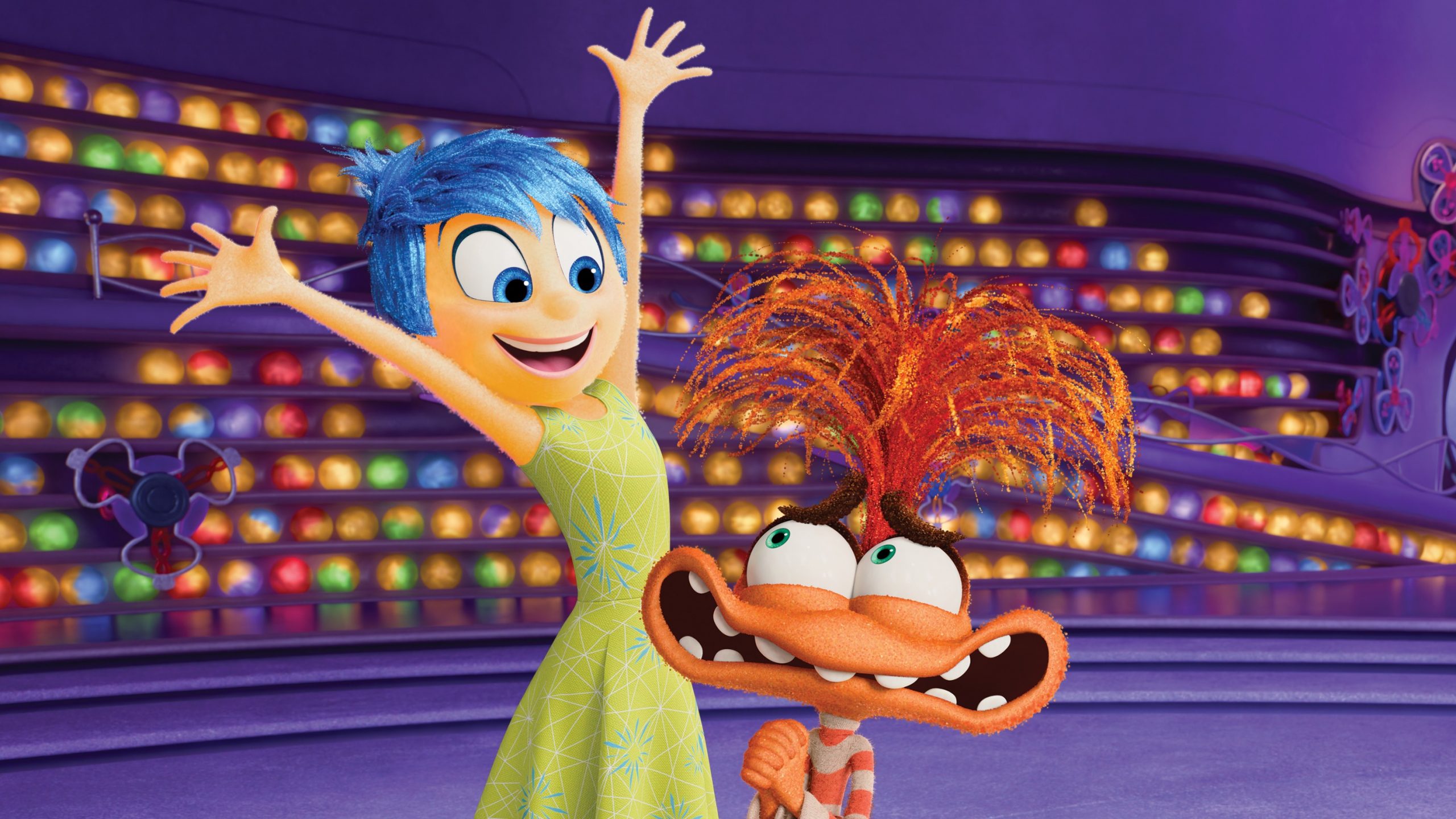
This article appears in the new issue of DEN OF GEEK magazine. You can read all of our magazine stories here.
When we last left Riley Andersen, the young protagonist of Pixar’s 2015 animated classic, Inside Out, she was 12 years old, and her still-developing mind was finding a way to balance all the core emotions of childhood, including Joy, Sadness, Anger, Disgust, and Fear. Nearly a decade later, Pixar is returning to the vast territory inside Riley’s mind as she turns 13 and enters adolescence with Inside Out 2. This time she’ll grapple with new emotions, changes to her psyche and body, and challenges both in her inner mind and the outside world.
With Inside Out director Pete Docter kicked upstairs to run Pixar since making the first film, the development of Inside Out 2 fell to a team led by longtime Pixar story supervisor and newly-minted director, Kelsey Mann, and returning producer Mark Nielsen (promoted from associate producer). Not only did Mann face the pressure of coming up with a sequel to one of Pixar’s most beloved films but he was also looking at the creative challenge of developing the idea for Inside Out 2 from essentially a blank slate.
“At the time, [Pete Docter] didn’t have a pitch as to what he wanted to do, but he thought I’d be a good person to go off and think about if there was a story to tell,” says Mann via Zoom ahead of the film’s release. “Another reason I love working with Pete is because he allows me to bring myself to the project versus telling me, ‘I want it to be about this and that, and I want you to direct it.’ He was like, ‘It’s open. Riley could be any age. It could be about anything. It’s really up to you.’ So I started with that.”
Mann knew early on that he wanted to revisit Riley as a teenager—not just because he was once one himself, but because at the time he was developing Inside Out 2, he was (and still is) raising two teenage daughters. Also with three girls of his own—two of them teenagers and one of them the same age as Riley in the film—Mark Nielsen says that real life and the creative process found themselves aligned.
“It’s a front row seat,” Nielsen jokes. “As we were making this movie, as we’re doing research, every day coming to work as we’re engaging with the subject matter and these emotions, you go home or you wake up in the morning, and there are those emotions showing up in full force because they come on strong at this age.”
Meet the New Emotions
In addition to setting the story on the cusp of Riley’s teen years, Mann knew from the outset that he wanted to introduce new emotions to the story, but wasn’t sure which ones to explore. “I remember meeting with Dacher Keltner, who’s a professor over here at Berkeley and our emotional expert on the first film,” Mann recalls. “I brought him in, and I said, ‘Which emotions show up at this age?’ Dacher said, ‘It’s all about the self-conscious emotions—the ones that start to compare yourself to others.’ And that really resonated for me because I looked at my own life and what I went through when I was a teenager.”
The emotions that Mann eventually settled on were Anxiety, Envy, Ennui, and Embarrassment. “You’re suddenly self-aware; you’re incredibly self-conscious,” he says, from personal experience, about Riley’s new feelings. “You start to look at yourself and see nothing but flaws. That was something I started to deal with at that age, and I still do. It’s still something I learned to manage. But it’s definitely something that is a big thing at that age. So I knew that the new emotions should be about, like, fitting in and not knowing whether you do or not.”
With Amy Poehler, Lewis Black, and Phyllis Smith returning to voice Joy, Anger, and Sadness respectively (along with Liza Lapira and Tony Hale replacing Mindy Kaling and Bill Hader as Disgust and Fear), the production team set about finding fresh actors to voice the new emotions, landing on Maya Hawke as Anxiety, Adèle Exarchopoulos as Ennui, Ayo Edebiri as Envy, and Paul Walter Hauser as Embarrassment.
“I wanted a division between the original emotions and the new emotions,” says Mann. “I think it was Amy Poehler who said they’re like the Gen Z emotions coming in. So I wanted to make sure that the new emotions who came in understood what Riley was going through now that she’s a modern teenager.”
Changes Inside and Out
On top of introducing new emotions, the world inside Riley’s mind, which undergoes extensive renovations in the story, was also expanded to include visualizing concepts such as beliefs. “What’s so cool about this world is we’re able to take complicated things that we all have in common but don’t have a visual vocabulary for. A good example from the first film would be memories,” says Mann, recalling the glowing, colored orbs of the first film.
“Now that Riley is a teenager, a big part of what goes on at that age is you start to become who you are as an individual, and part of that is you start forming your own beliefs,” the director continues. “I’ve got a belief system, you’ve got a belief system, what does it look like? I’m excited about what we came up with because not only is it someplace really beautiful, but it looks amazing on the big screen, and it’s really emotional too.”
While the changes both inside Riley’s head and in the outside world required new designs for the production team, the ongoing march of technology in animation meant that it wasn’t easy to just recreate elements from the first movie, such as the original characters or the look of Headquarters, the operational center of Riley’s brain.
“You’d think we could just go make another movie because didn’t they build all that nine years ago for Inside Out?” says Nielsen. “Well, the answer is no. Technology has marched on. We are not using technology at Pixar that can make Joy anymore. The shading and the lighting, and all that had to be completely done all over again from scratch, using new technology, but making it look like the character that you remember seeing from the first movie.”
While the tech to bring Inside Out 2 to life has changed, and while the character of Riley is meeting a whole new range of emotions and life experiences for the first time, one thing that Nielsen says hasn’t changed is the universal appeal of this story, which touched so many viewers so deeply the first time and which he and Mann hope to recapture again.
“I think the target audience is anybody who has emotions,” says the producer. “It was so important to us that we create a universal story with this one. There’s so much fun to be had exploring what is going on inside our heads. Riley in this film could be you. It could be me. She’s experiencing emotions in this film that everybody in the audience is going to relate to. So like the first film, I think this one’s for everybody.”
Inside Out 2 opens in theaters on June 14.
The post How Pixar’s Inside Out 2 Deals With Riley’s New ‘Gen Z Emotions’ appeared first on Den of Geek.







